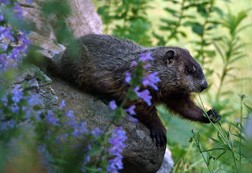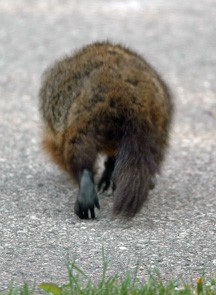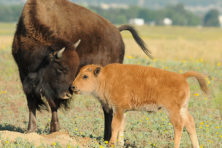Mammal Meteorologist – the Groundhog
- Share
- Tweet
- Pin
- Share
It was in early June of 1933 shortly after school let out that my Dad drove our family of five in his 1933 Plymouth sedan for a weekend vacation to see Mom’s Aunt Inga and her son Russell. They lived in the wilds of the Upper Peninsula of Michigan several miles from Perronville, where Russell made a living cutting Quaking Aspen, or “popple” as they called it, for the paper mills.
Excitement was in the air when we arrived at their tiny wilderness homestead. A Woodchuck had been digging too many holes in their small field, and Cousin Russell with the help of his little Terrier was trying to get rid of the pesky digger. He explained that he had to kill the animal because he was afraid their lone cow might step into one of the holes and break her leg.

The Woodchuck’s grizzled fur, black nose and tail show well here.
Dad, my two older brothers Ivan and Leo, and I at 4 years of age watched in fascination as the drama unfolded. The dog, small enough to crawl into the Woodchuck’s tunnel, let us know by his growling that this was serious business. And we all appreciated that there was indeed a scrappy animal down there when the Woodchuck got hold of the Terrier, bit him severely on his mouth and tongue, and knocked him out of the battle.
Russell became more determined than ever to do away with the Woodchuck and worked in earnest until at last he succeeded. My Dad, sensing the end was near, managed to get us boys away long enough to shield our innocent eyes from the killing blow. Later, as the dead Woodchuck lay atop a fence post in the open sun near the yard, I couldn’t help but sympathize with it as I stroked its sleek warm fur. That turned out to be my first and most memorable experience with one of these creatures.
After having experienced 84 consecutive Groundhog Days, I join the great majority of people who are totally convinced that our fellow Groundhog is no skilled meteorologist. But leave it up to “Phil,” the famous Groundhog from Punxsutawney, Penn., to add plenty of good old-fashioned fun to this famous day which arrives at a time when everyone at our latitude is ready for spring. Let’s face it; spring in Wisconsin hardly ever comes early.

The fur of this Woodchuck is browner.
This year on Feb. 2 it was 3 degrees F at dawn with a clear sky—at least a solar day to help heat our house. According to folklore we were due for another six weeks of winter. I write this about seven weeks later, on Mar. 24, with the dawn temperature sagging at 6 degrees F. Yes, the Groundhog had made an accurate “prediction”!
Deep down I get the feeling that perhaps we’re headed for another so-called Little Ice Age. This occurred from the early 14th century through the mid-19th century, especially during the 17th century, with longer winters and cooler summers which disrupted growing seasons and destroyed harvests across Europe.
I find it fascinating that what we refer to as the Woodchuck, which is neither big nor powerful, appears to be clumsy and tubby, cannot run fast or far, is not good-looking and surely isn’t smart, has a special day of the year, Feb. 2, honoring it – Groundhog Day!
Charlotte and I happened to be driving south along nearby County Hwy. T during the late morning of March 17 when we were surprised to see a rather lean, skinny Woodchuck scurrying across the deep and firmly packed snow very close to and parallel with the road. My immediate thought was that it was a male diligently searching for a female with which to mate. His very good sense of smell would enable him to locate her den and, with his powerful digging skill excavate his way through a few feet of snow to get to her. Their breeding usually occurs between March 1 into early April. By this time these animals will be relatively weak and thin, having lost between 30-40 percent of their weight during hibernation.

Our American Bellflowers are being enjoyed by “Chuck!”
This heaviest member of the Squirrel family, between four and nine pounds, is strictly a vegetarian. Upon leaving its winter den where it spent four to six months, body temperature hovering between 43-57 degrees F., the Groundhog will feast upon the bark and buds of various trees and early appearing dandelions. Gradually their fondness for clover, alfalfa, beans, peas, wheat and oats will have them “hog-fat” in no time. They are known to be extremely fond of ripe raspberries, cherries and apples, and also some garden flowers.
One took a liking several years ago to our American Bellflowers growing near the retaining wall about 30 feet from our front door and pretty much wiped them out in a few days. Another dug its way under our garden fence and did great damage to one of our raised beds and everything growing within it. Groundhogs are protected by law in our state, so a special permit to eradicate one of these potentially destructive animals must be obtained from the DNR.

The smooth black soles of the Woodchuck’s rear foot.
Statewide their population is estimated at between four and five per square mile. Their home range is surprisingly small, roughly 200-300 feet from their home burrow. The young will be born any time between early April and early May.
The Groundhog is known for its short thickset body, being 16-29 inches long including its tail, which can be from four to six inches long. Its head is broad and its small ears are not prominent. The animal’s short powerful limbs and curved thick claws are ideally suited for digging. It has two coats of hair, a dense grey undercoat and a longer outer coat of “guard hairs” giving the Groundhog its distinctive frosted appearance. The crown of the head is black, often faded with scatterings of whitish-buff hairs around the nose-pad, extending onto the cheeks. Usually a little whitish may be seen over each eye. Its feet and bushy tail are almost always black. The one I photographed as it lumbered away from me showed quite clearly the large hairless undersides of its feet.
After many years of trying, I still have yet to come up with the answer to the age-old question, “How much wood could a Woodchuck chuck if a Woodchuck could chuck wood?” Have you?


